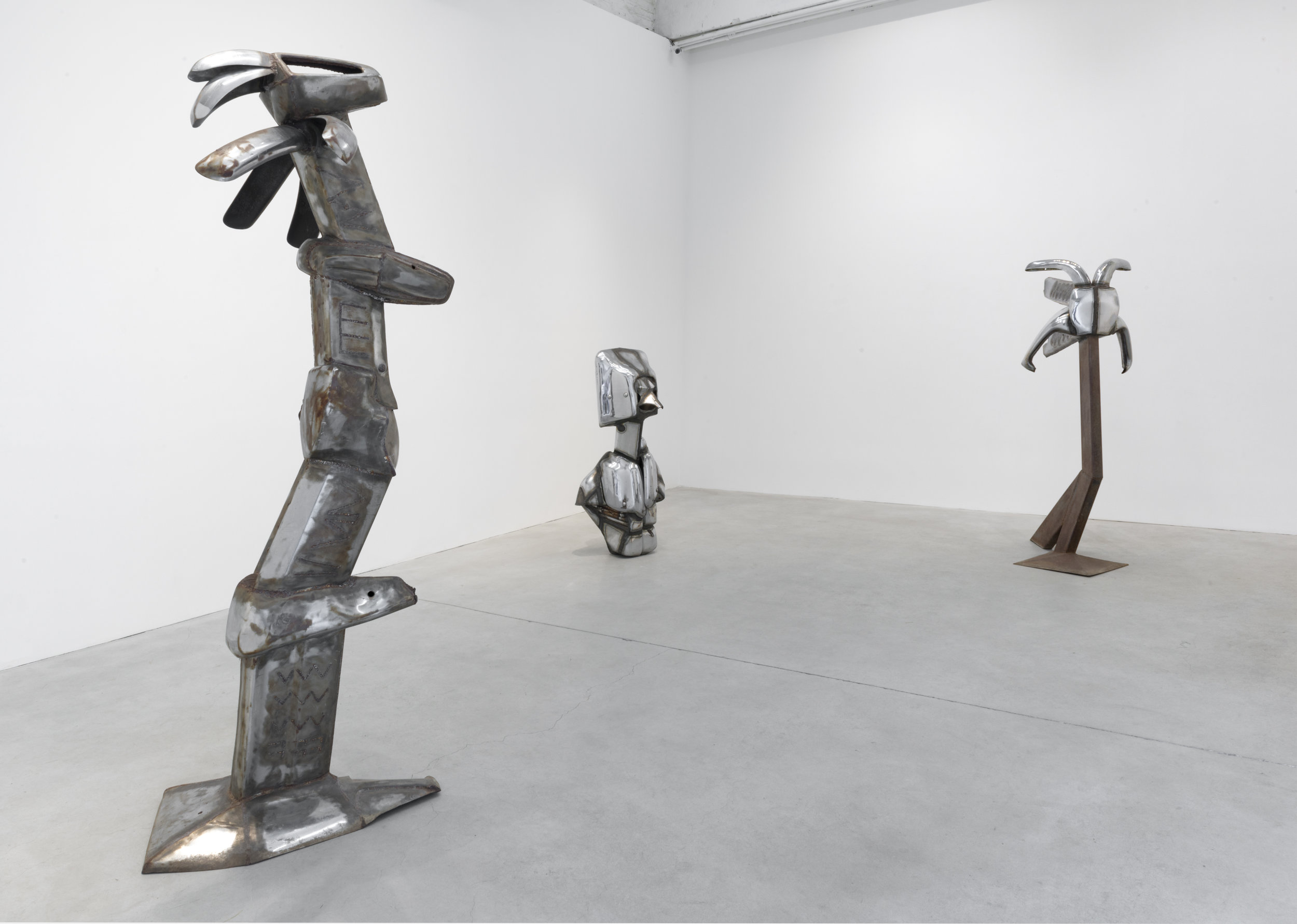Ed Love Heroes at Kravets|Wehby Gallery NY
“Commodified object in his strong hands became totemic. It became totemic in the sense of rediscovered possibilities of allegory and moral allusion.” – Robert Farris Thompson
Heroes, on view at Kravets|Wehby Gallery in West Chelsea New York, features an intimate and inspiring posthumous exhibition of welded chrome and steel sculptures from former Washington, DC based artist, Ed Love. The eight-works displayed, all produced in the 1970s, reflect a period of extreme productivity for Love. In 1976 the artist exhibited a solo show of his sculptures at the Corcoran Gallery of Art and served as a faculty member at Howard University from 1969 to 1987. Studying and teaching at “The Mecca,” facilitated opportunities for him to be mentored and work alongside many other prolific, world renowned artist-scholars; Elizabeth Catlett, Alma Thomas James D. Herring, Valerie Maynard, James A. Porter, Lou Donaldson, Sam Gilliam, David C. Driskell, Lou Stovall, and Sylvia Snowden, among others. The works created by Love and his peers left an indelible mark, a defining proclamation that not only made black aesthetics more visible, but also widened opportunities for contemporary art institutions to consider the relevance of radical, affirming and challenging representations of the black experience. Without the contributions of those artists, and many others unnamed, who each expanded the visualization, inclusion, and canonization of black aesthetics, there would be no Kehinde Wiley, Amy Sherald, Ebony G. Patterson, Derrick Adams. No Sheldon Scott, Wangechi Mutu, Nate Lewis, Tsedaye Makonnen, or Adrienne Gaither. The struggles of earlier generations against the omission of black creatives from art markets is integral to the dynamic representations of contemporary art makers we see globally exhibited and celebrated today.
The Senator (Image courtesy of Kravets/Wehby Gallery)
Faena 2 - The Killing of Clifford Glover (Image courtesy of Kravets/Wehby Gallery)
Love’s innovative use of found scrap metal and discarded car parts to develop welded chrome and steel sculptures eternally shifted the possibilities for how artists could engage sculpture as a medium, and as an intersectional tool to historicize a confluence of African histories. Love’s works converge lived and mythologized black narratives into monuments, and revises cosmological archetypes and black vernacular soundscapes into totems -- bold sculptures that exist beyond the constructs that shape them. The resultant forms reflect a sublime intentionality, and Love’s pronounced ability to envisage interplays between complex design structures and space. His process exemplifies the supernatural adaptability of pre-colonial and post-colonial African Diasporic identities. Many of the sculptures featured in Heroes rupture phenomenological explanations for the perceived relationships between mass, weight and gravity. Love’s forms, deeply influenced by Senufo, Yoruba and Egyptian cosmologies, and the gestural nuances of Jazz performances are not stoic-- they float, dance, and hover between dimensions.
Curator Marc Wehby notes that Heroes is “an investigation of heritage.” Love’s consideration of the personal and mythologized narratives that inform and unite collective diasporic histories resonate through the stunning steel memorials that he creates. His art is an art of accessibility; he used the readily available and affordable materials within his community to make new objects into refined forms. The black aesthetics Heroes venerates are most compelling because of the materials they are created from. Love makes gods of garbage, refreshed fetishes, protective icons, and deconstructed anthropomorphic figurations to honor the many unnamed figures, spirits, and black lives who deserve admiration and devotion.
(Image courtesy of Kravets/Wehby Gallery)
“Faena 2- The Killing of Clifford Glover,” presents a dynamic representation of Love’s subtle politicization and reverence for black life. The sculpture memorializes the 1973 murder of Clifford Glover, a ten-year-old boy who was shot and killed by an officer in Queens, New York. Love renders Glover as an abstract figuration, a bull cranium, that is welded to the top of a towering and corroded steel beam. The details of the bull head are erased, its structure is pared down and elongated into a splayed mouth, an immense symbolic reference to the recurrent martyrdom of black boys and men. A small inscription with the title of the work is carved into the chrome head, contextualizing Glover’s death within a global history of racialized violence.
The term faena is attributed to Spanish bullfighting traditions, and is used to define the last series of wounds a matador inflicts before finally killing the bull. In the seminal text, The Isis Papers, Historian Dr. Francis Cress Welsing wrote extensively about histories of colonization, power, and popular culture. The history of Moorish occupation in Spain lasted for roughly two hundred years, 711 AD to 997 AD. The following passage from the text suggests that bullfighting, and the specific gesture of killing the bull, could celebrate the Moors expulsion from Spain; or more generally revel in the legacy of white supremacist colonization around the world.
“In the bull ring, the bull is usually black. The bullfighter is usually a white male or any male in a “suit of lights,” meaning white. The bull is chased and tormented until it is killed. This killing goes on obsessively, as a symbol of white survival in the presence of the Black male threat; symbolic of white males conquering Black males or of white survival in a world populated mostly by non-white people.[1]”
A Dictionary of Symbols, by Spanish scholar C.J. Cirlot, provides another incredibly revelatory reference about the power of symbols and its relationship to racialized identity. Cirlot’s descriptions for the words “negro” and “bull” are astounding; black bodies are conflated with animals, slaughter of black bodies at the hands of white men is simplified as a battle between superior and inferior, light forces and evil darkness. Love tugs at these histories and presents them as layered, densely referential archives that chronicle the ideological and performed championing of black death as sport.
Clifford Glover is Tamir Rice, Oscar Grant, Sean Bell, Trayvon Martin. Their murders have catalyzed a continuum of rally cries, protests and rebellions against centuries of egregious violations. What god do you turn to for retribution? To whom do you pray for protection? Love turns to the mythology of Nile Valley Civilizations, and re-imagines one incarnation of the Egyptian deity Heru/Horus. In “Horus the Avenger”, Love renders a steel and chrome sculpture in the likeness of “Heru/Horus the Child”, a representation of the avian god as a small falcon or hawk with his fingertips perched on its waist, and a large crown atop its head. Myths about the birth and first flight of Horus astrologically associate him with the sun, and assert him as a significant unifying force for the upper and lower realms of ancient Egypt, as well as a symbol for the unification of god and man. Love’s “Horus the Avenger” is a direct response to “Faena 2- The Killing of Clifford Glover” that offers affirming reflections of black sons/suns as gods.
In 1986, art critic and writer Paul Richard penned a review for The Washington Post about Love’s work. In it he praises Love for his vision and blatantly challenges DC art museums to acknowledge their exclusion of his work.
“So strong are his passions that most of Washington’s museums, notably excepting the WPA, also shy away. One wishes this city were less timid, or would learn to pay attention to the competent, committed artists in its midst.[2]”
(Image courtesy of Kravets/Wehby Gallery)
Ed Love transitioned in 1999. It is unfortunate to find that forty years after the creation of the works featured in Heroes, Love’s legacy remains obscure, his sculptures are rarely exhibited, and his contributions are regularly excluded from critical dialogue and scholarship. It is troubling, but not surprising that very few of museums, galleries and institutions in Washington, DC have supported, exhibited or collected Love’s works. Those omissions are a part of the siloed and exclusive history of the city, which even at the peak of its chocolate mass, isolated and ignored black artists. We are fortunate to see that trend shift, and to witness a global clamoring for groundbreaking works by contemporary black artists. Art historians, gallerists, museums, curators should remember Ed Love, collect his work, and contextualize it alongside other trailblazers from the DMV whose relevance and talent continue to inspire new generations of artists.
[1] Welsing, F. C. (1991). The Isis (Yssis) papers. Chicago: Third World Press.
[2] Richard, Paul. (1986,September, 15) Ed Love’s Scrap Yard Spirits. The Washington Post. Archives.




